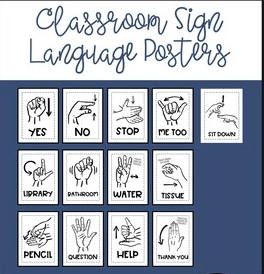Student Contributor: G. Bunten
 This tool is an effective way for students to come and go from the classroom without it being a distraction. The signs are a quick and easy way to get student opinions on “yes” or “no” questions.
This tool is an effective way for students to come and go from the classroom without it being a distraction. The signs are a quick and easy way to get student opinions on “yes” or “no” questions.
This tool is a way for students to non-verbally communicate with the teacher when asking simple questions such as asking to use the restroom. Students will be taught the signs in the beginning of the year and are a way for the teacher to maintain classroom management without getting interrupted multiple times when assisting other students, talking to adults, etc. Some elements that my mentor includes that vary from classroom to classroom are that students are unable to leave the classroom while she is teaching unless it is an emergency. From my experience this tool has made the management run smoothly and students aren’r interrupting with repetitive questions.
This tool relates to the Theories of Influence by it being a teacher-directed tool because the signs are already chosen before the school year starts. Signs that are used are not collaboratively decided. Teachers could make this tool collaborative by having the class determine how many signs they would like to use .This tool would fall under the preventative phase because it prevents classroom disruptions and creates quick responses. The signs prevent distractions and getting other students off task. It could relate to the corrective phase if students are having issues with frequently interrupting lessons to ask to use the restroom.
More Information –
Tool Source: Mrs. Becker

